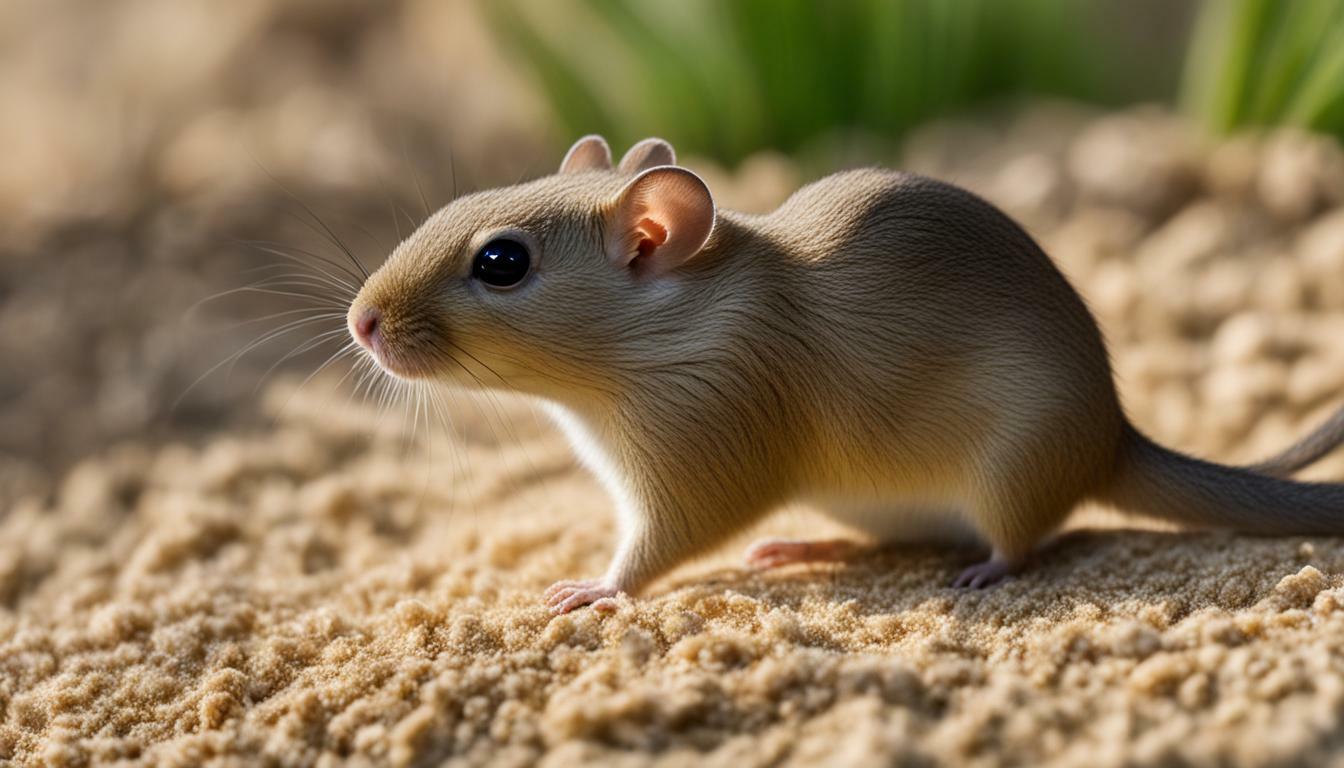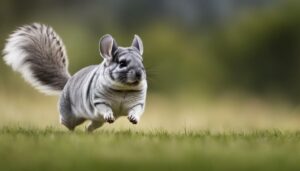Yes, gerbils do have tails, and they play an important role in their lives. However, there is a condition called “gerbil tail slip” where the tail’s skin and fur can slip off, usually due to poor handling. In the wild, tail slip serves as a defense mechanism for gerbils to escape from predators. In domestic settings, it is typically caused by improper handling, such as grabbing the gerbil by the tail. If a gerbil loses its tail, it can lead to severe injury and infection, and veterinary care may be required, including tail amputation if necessary. While gerbils cannot regrow their tails, they can adapt and live a normal life without them. To prevent tail slip, it is essential to handle gerbils properly and provide a safe enclosure.
Key Takeaways:
- Gerbils have tails, but they can lose them in a condition called “gerbil tail slip.”
- Tail slip is a defense mechanism in the wild and usually occurs due to improper handling in domestic settings.
- If a gerbil loses its tail, it may require veterinary care, including possible tail amputation.
- Gerbils can adapt and live a normal life without their tails.
- To prevent tail slip, gentle handling techniques and a safe enclosure are crucial.
The Anatomy of a Gerbil Tail
Gerbil tails vary in length depending on the species, but all gerbils have tails that serve specific purposes. The tail of a gerbil is a slender and flexible structure composed of vertebrae, muscles, skin, and fur. It is an important part of their body that aids in various functions.
The length of a gerbil’s tail can range from a few centimeters to several inches, depending on the specific species. For example, the Mongolian gerbil (the most common pet gerbil) generally has a tail that is around 5-10 centimeters long. On the other hand, the fat-tailed gerbil has a shorter and stubbier tail.
The gerbil tail has several purposes and functions. It helps with balance and coordination, allowing gerbils to navigate their environment with agility. The tail also acts as a communication tool, as gerbils use it to convey their emotions and intentions to other gerbils. Additionally, the tail serves as a storage organ, enabling gerbils to store fat reserves that they can utilize when food is scarce.
The Importance of Proper Handling
It is crucial to handle gerbils with care to avoid causing harm to their delicate tails. Gerbils have what is known as a “skin-slip” response, where their tail skin and fur can easily slip off if grabbed or tugged forcefully. This condition, known as gerbil tail slip, can result in severe injury, pain, and even infection for the gerbil.
To prevent gerbil tail slip, it is essential to follow proper handling techniques. Always approach gerbils gently and avoid grabbing or pulling their tails. Instead, support their bodies with both hands, letting their tails rest naturally. This way, you can ensure the safety and well-being of your gerbil and maintain a strong bond of trust with your furry friend.
| Tips for Proper Gerbil Handling |
|---|
| Approach gerbils calmly and quietly, minimizing sudden movements. |
| Support their bodies with both hands, allowing their tails to rest naturally. |
| Avoid grabbing or pulling their tails. |
| Do not force them to be handled if they are showing signs of stress or discomfort. |
By handling gerbils properly and providing a safe and enriching environment, you can ensure the well-being and happiness of these adorable pets. Remember, a little love and care go a long way in fostering a strong bond with your gerbil.
Gerbil Tail Gender Differences
While there may be slight differences in tail length between male and female gerbils, it is not a definitive rule. The length of a gerbil’s tail can vary depending on various factors, including genetics and individual variation. It is important to note that the length of the tail does not determine the gender of a gerbil.
Male gerbils are generally larger than females and may appear to have longer tails. However, this is not always the case, as there can be variations within each gender. Some female gerbils may have tails that are just as long as those of males, while some males may have shorter tails compared to other males.
It is also worth mentioning that tail length does not necessarily indicate the overall health or well-being of a gerbil. The most important factor is to ensure that the gerbil’s tail is intact and free from any signs of injury or infection. If you notice any abnormalities with your gerbil’s tail, such as discolouration, swelling, or loss of fur, it is recommended to consult a veterinarian for a thorough examination and appropriate treatment.
Remember, when handling gerbils, it is crucial to do so with utmost care and gentleness. Avoid grabbing or pulling their tails, as this can cause them undue stress and potentially lead to tail slip. By providing a safe and secure environment for your gerbils and handling them properly, you can help prevent any potential issues related to their tails and ensure their overall well-being.
| Tail Length | Gender |
|---|---|
| Slightly longer | Male gerbils |
| Variations | Female gerbils |
| No definitive rule | Tail length does not determine gender |
Gerbil Tail Slip: Causes and Effects
Gerbil tail slip is a condition where the tail’s skin and fur slip off, and it can have serious consequences for the gerbil’s health. This condition is commonly caused by improper handling, such as pulling or grabbing the gerbil by its tail. The tail is a sensitive part of the gerbil’s body, and rough handling can result in the skin and fur detaching from the tail.
When a gerbil experiences tail slip, it can lead to severe injury and infection. The exposed tail tissue is vulnerable to bacterial infections and can become painful for the gerbil. If left untreated, tail slip can even result in the loss of the tail altogether. In some cases, veterinary intervention may be necessary, and the gerbil’s tail may need to be amputated to prevent further complications.
In the wild, gerbil tail slip serves as a defense mechanism. When a predator tries to attack a gerbil, the tail slips off, allowing the gerbil to escape while the predator is left with only a portion of the tail. This unique adaptation helps gerbils protect themselves from predators and survive in their natural habitats.
| Cause | Effect |
|---|---|
| Improper handling (grabbing the tail) | Tail skin and fur slipping off |
| Severe injury and infection | Pain and potential loss of the tail |
| Defense mechanism in the wild | Allows gerbils to escape from predators |
| Veterinary treatment (amputation) | Prevents further complications |
If you have gerbils as pets, it’s crucial to handle them gently and avoid grabbing them by their tails. Always support their bodies and allow them to move freely without putting unnecessary pressure on their tails. Providing a safe enclosure with appropriate hideouts and toys can also help prevent accidents and injuries that may lead to tail slip.
Gerbil Tail Slip in the Wild
In the wild, gerbil tail slip is an important adaptation that helps gerbils evade predators and protect themselves. When a gerbil is caught by its tail, the skin and fur can slip off, allowing the gerbil to escape while leaving the predator with only a piece of the tail. This remarkable defense mechanism allows gerbils to survive in their natural habitats.
Gerbil tail slip serves as a distraction technique for predators. When a predator grabs onto the gerbil’s tail, the skin and fur detach easily, making it difficult for the predator to maintain a grasp on the gerbil. This enables the gerbil to flee to safety and gives it a chance to regenerate a new tail.
The ability to lose their tails also benefits gerbils in other ways. In case a gerbil becomes trapped or stuck, it can release its tail and escape to freedom. This unique adaptation demonstrates the incredible resilience and survival instincts of these small creatures.
| Gerbil Tail Slip in the Wild | Information |
|---|---|
| Defense Mechanism | Gerbil tail slip allows them to escape predators by shedding the tail’s skin and fur. |
| Distraction Technique | This defense mechanism confuses predators, giving gerbils an opportunity to flee. |
| Adaptation for Survival | Gerbils can release their tails to escape from traps or dangers in their environment. |
These remarkable features of gerbil tail slip showcase the ingenuity of nature and the fascinating adaptations that animals develop to ensure their survival. It is a reminder of the delicate balance of predator and prey in the wild, where each species must rely on its unique characteristics to thrive.
Gerbil Tail Slip in Domestic Settings
Tail slip in domestic gerbils is usually caused by improper handling, and it is crucial to handle these small creatures with care. Gerbil tails are delicate and sensitive, consisting of fragile skin and fur that can easily slip off if mishandled. To avoid tail slip, it is important to remember a few essential guidelines when interacting with your pet gerbil.
1. Gentle and Controlled Approach: When picking up a gerbil, always use a gentle and controlled approach. Cup your hands to create a secure and supportive grip, ensuring that you do not grab the gerbil by the tail. By handling them with care, you can minimize the risk of their tails slipping.
2. Avoid Rough Play: Gerbils are active and curious creatures, but it is important not to engage in rough play that could lead to accidents resulting in tail slip. Avoid pulling on their tails or allowing them to jump from heights that could injure their delicate tails.
3. Educate and Supervise Children: If children are interacting with gerbils, it is crucial to educate them about proper handling techniques. Supervise their interactions to ensure that they are not mishandling the gerbils or causing unnecessary stress to the animals.
| Causes of Tail Slip in Domestic Gerbils | Improper Handling Techniques |
|---|---|
| Grabbing the gerbil by the tail | Twisting or pulling the tail forcefully |
| Allowing the gerbil to jump from heights | Engaging in rough play that may lead to accidents |
| Not supporting the gerbil’s body properly | Handling the gerbil too roughly or with excessive force |
It is essential to be mindful of these factors and take appropriate measures to ensure the well-being of your pet gerbil. By handling them gently, providing a safe enclosure, and educating others on proper gerbil handling, you can prevent tail slip and promote a healthy and happy life for these adorable creatures.
Treating Gerbil Tail Slip
If a gerbil experiences tail slip, it may require veterinary treatment, including the possibility of tail amputation to prevent further complications. Gerbil tail slip is a condition where the skin and fur of the tail slip off, leading to potential injury and infection. It is important to seek professional care for a gerbil with a slipped tail to ensure its health and well-being.
When visiting a veterinarian for tail slip treatment, they will assess the severity of the condition and determine the best course of action. In some cases, if the tail is severely damaged or prone to infection, tail amputation may be recommended. Although this may sound drastic, it is a necessary measure to prevent further complications and promote the gerbil’s recovery.
The veterinary treatment for gerbil tail slip goes beyond just the amputation procedure. It also includes proper wound care and medication to prevent infection and aid in the healing process. Your veterinarian will provide detailed instructions on how to care for your gerbil after the procedure, ensuring its comfort and promoting a swift recovery.
| Treatment for Gerbil Tail Slip | Benefits |
|---|---|
| Tail amputation | Prevents further complications and promotes healing |
| Wound care and medication | Prevents infection and aids in the healing process |
Gerbil Tail Adaptation
Gerbils are resilient creatures and can adapt to living without a tail, continuing their day-to-day activities without significant hindrance. While their tails play an important role in balance and communication, gerbils have developed remarkable ways to compensate for their loss.
One of the ways gerbils adapt is by relying more on their hind legs. These agile little rodents use their powerful hind limbs to maintain stability and navigate their surroundings. Their remarkable jumping and leaping abilities allow them to overcome any challenges that may arise from not having a tail.
In addition to their hind legs, gerbils also utilize their heightened senses to adapt without a tail. Their keen sense of smell and sharp hearing enable them to detect danger and react quickly. With these heightened senses, gerbils are adept at evading predators and ensuring their survival even without their signature appendage.
| Gerbil Tail Adaptation | Impact on Gerbil Behavior |
|---|---|
| Enhanced Hind Leg Strength | Increased agility and jumping ability. |
| Heightened Senses | Improved detection of predators and quick reaction times. |
| Collaborative Burrowing | Efficiently create complex tunnel systems. |
“Gerbils are incredibly adaptable creatures. Even without their tails, they are capable of living a normal life and engaging in all their natural gerbil behaviors.” – Dr. Emily Johnson, Veterinarian
Furthermore, gerbils have a unique ability to adapt their burrowing behavior. In their natural habitat, gerbils are prolific diggers, creating intricate tunnel systems. Despite the absence of a tail, gerbils collaborate to excavate tunnels and chambers within their enclosures. Through teamwork and coordination, they create a safe and secure environment to live and thrive.
Overall, gerbils prove themselves to be resilient and resourceful animals when it comes to adapting without a tail. They rely on their strong hind legs, heightened senses, and collaborative abilities to carry on with their normal gerbil activities. By providing a suitable habitat and attentive care, you can ensure that your tail-less gerbil leads a fulfilling and healthy life.
Proper Handling Techniques to Avoid Tail Slip
To avoid tail slip, it is crucial to handle gerbils using proper techniques that prioritize their safety and well-being. Improper handling, such as grabbing a gerbil by its tail, can cause the skin and fur to slip off, leading to severe injury and potential infection. Here are some essential guidelines to follow when handling your furry friends:
- Gentle Approach: Always approach your gerbil calmly and gently. Make slow and deliberate movements to avoid startling or agitating them. This will help build trust and reduce the likelihood of tail slip.
- Support the Body: When picking up your gerbil, ensure you provide proper support for its body. Use both hands to scoop up the gerbil, cradling it close to your chest. Avoid grabbing or pulling its tail, as this can cause serious harm.
- No Tugging: Never pull on a gerbil’s tail, even if they resist being handled. Tugging on their tail can result in tail slip, pain, and distress. Instead, gently coax them into your hands using treats or by creating a comfortable and secure environment.
- Safe Holding: Once you have securely picked up your gerbil, hold it close to your body to provide a sense of security. Make sure your grip is gentle but firm, ensuring your gerbil cannot wriggle free and potentially injure itself.
Creating a Safe Environment for Your Gerbils
Handling gerbils properly is only one part of ensuring their well-being. It is also important to provide a safe enclosure that minimizes the risk of accidents and injuries that can lead to tail slip. Follow these tips to create a secure gerbil habitat:
- Avoid Small Gaps: Make sure the cage or enclosure you provide for your gerbils has bars or mesh that are closely spaced. This prevents them from trying to squeeze through and potentially getting their tails caught.
- Soft Flooring: Line the bottom of the cage with a soft, solid surface. Avoid wire-bottomed cages or rough substrates that can cause injuries to their delicate tails.
- Remove Hazards: Regularly inspect the cage for any sharp edges, protruding nails, or objects that could cause harm. Remove any potential hazards to prevent accidental injuries to your gerbil’s tail.
By following proper handling techniques and creating a safe environment, you can help prevent tail slip and ensure the well-being of your gerbils. Remember, gentle and considerate handling goes a long way in maintaining a happy and healthy relationship with your furry companions.
Providing a Safe Enclosure for Gerbils
Creating a safe environment for gerbils is essential to minimize the risk of tail slip and ensure their overall well-being. Gerbils are active and curious creatures, and they need a secure habitat that caters to their natural behaviors and instincts.
When setting up a gerbil enclosure, it is important to choose the right materials and ensure proper construction. Avoid using wire cages with large gaps that could trap or injure their delicate tails. Instead, opt for a glass or plastic tank that provides ample space for gerbils to move around without the risk of tail entrapment.
Additionally, it is crucial to provide suitable bedding that is soft and absorbent. Avoid materials that can get tangled in their tails, such as string or shredded paper. Aspen or paper-based bedding is a good option as it is safe and comfortable for gerbils to burrow and nest in.
| Key Factors for a Safe Gerbil Enclosure | Additional Information |
|---|---|
| Size | Aim for a minimum of 10 gallons per gerbil to allow for ample space for exercise and exploration. |
| Enrichment | Include tunnels, hiding spots, and chew toys to keep gerbils mentally stimulated and prevent boredom, which can lead to tail chewing. |
| Temperature | Maintain a consistent temperature between 65-75°F (18-24°C) to ensure gerbils are comfortable. |
| Location | Place the enclosure in a quiet area away from direct sunlight and drafts. |
| Substrate | Provide a bedding layer that is at least 2-3 inches deep to allow gerbils to dig and burrow safely. |
By following these guidelines and providing a safe and enriching environment for your gerbils, you can reduce the risk of tail slip and promote their overall health and happiness. Remember, gentle and proper handling techniques are also essential to prevent injuries and maintain the well-being of these delightful pets.
Gerbil Tail: A Fascinating Feature
Gerbil tails are not only functional but also fascinating, offering insight into the world of these captivating rodents. The tail of a gerbil serves multiple purposes, playing a vital role in communication, balance, and even survival.
One interesting fact about gerbil tails is that they are covered in fur, just like the rest of their body. Their tails are not simply naked appendages; they are an extension of their soft and fluffy coat. This fur-covered tail helps gerbils regulate their body temperature, keeping them warm during colder periods.
Another intriguing aspect of gerbil tails is their ability to shed or slip. When a gerbil feels threatened or in danger, it can purposely detach its tail as a means of escape. This fascinating defense mechanism, known as “gerbil tail slip,” allows the gerbil to distract predators by leaving behind a wriggling tail while it makes a quick getaway. It is truly a remarkable adaptation that showcases the ingenuity and survival instincts of these small creatures.
| Gerbil Tail: A Fascinating Feature | |
|---|---|
| Function | Gerbil tails serve various functions, including balance, communication, and temperature regulation. |
| Tail Shedding | When threatened, gerbils can intentionally shed their tails as a defense mechanism, allowing them to escape from predators. |
| Temperature Regulation | The fur-covered tail helps gerbils regulate their body temperature, keeping them warm during colder periods. |
| Adaptation | Gerbils can adapt and live a normal life even without their tails, showcasing their resilience and ability to thrive. |
It’s important to note that gerbils cannot regrow their tails once they have shed them. Furthermore, tail loss due to improper handling can be detrimental to their health and well-being. Gerbil owners must exercise caution and handle these delicate creatures gently, avoiding grabbing them by the tail.
Providing a safe and secure enclosure is equally important in preventing tail slip. By creating a gerbil habitat that minimizes the risk of accidents and injuries, owners can help ensure the overall welfare of their beloved pets. Remember, a happy and healthy gerbil is a gerbil with a well-cared-for tail!
Conclusion
Understanding the importance of gerbil tails and taking necessary precautions can help ensure the health and happiness of your gerbil companions. Gerbils do have tails, but they can be at risk of losing them in a condition known as “gerbil tail slip.” This occurs when the skin and fur of the tail slip off, typically due to poor handling.
In the wild, gerbil tail slip serves as a defense mechanism, allowing these small rodents to escape from predators. However, in domestic settings, tail slip is usually caused by improper handling practices, such as grabbing the gerbil by its tail. If a gerbil loses its tail, it can lead to severe injury and infection, and veterinary intervention may be necessary, including possible tail amputation.
It’s important to note that gerbils cannot regrow their tails, but they are adaptable creatures and can live a normal life even without them. To prevent tail slip, it’s crucial to handle gerbils properly and provide a safe enclosure for them. Gentle and safe handling techniques should be practiced, avoiding any actions that may put stress or strain on their delicate tails.
By creating a secure and enriching habitat, you can reduce the risk of accidents that can lead to tail slip. Ensuring that the enclosure has appropriate bedding and toys, and regularly inspecting the environment for any potential hazards, can greatly contribute to your gerbil’s well-being.
FAQ
Do gerbils have tails?
Yes, gerbils do have tails. However, they can lose them in a condition called “gerbil tail slip.”
What is gerbil tail slip?
Gerbil tail slip occurs when the skin and fur of the tail slip off, often due to poor handling. In the wild, it is a defense mechanism that allows gerbils to escape from predators.
How does tail slip happen in domestic gerbils?
Tail slip in domestic gerbils is usually caused by improper handling, such as grabbing the gerbil by the tail. It is important to handle gerbils gently and avoid pulling on their tails.
Can a gerbil live without its tail?
Yes, a gerbil can adapt and live a normal life without its tail. However, losing a tail can lead to severe injury and infection, so it’s important to seek veterinary care for a gerbil with a slipped tail.
Can gerbils regrow their tails?
No, gerbils cannot regrow their tails. Once a tail is lost, it will not grow back. However, gerbils can still lead a happy and healthy life without their tails.
How can tail slip be prevented?
Tail slip can be prevented by handling gerbils properly. It’s important to avoid grabbing them by the tail and instead support their body when picking them up. Providing a safe enclosure with no sharp objects can also help prevent accidents that could cause tail slip.




